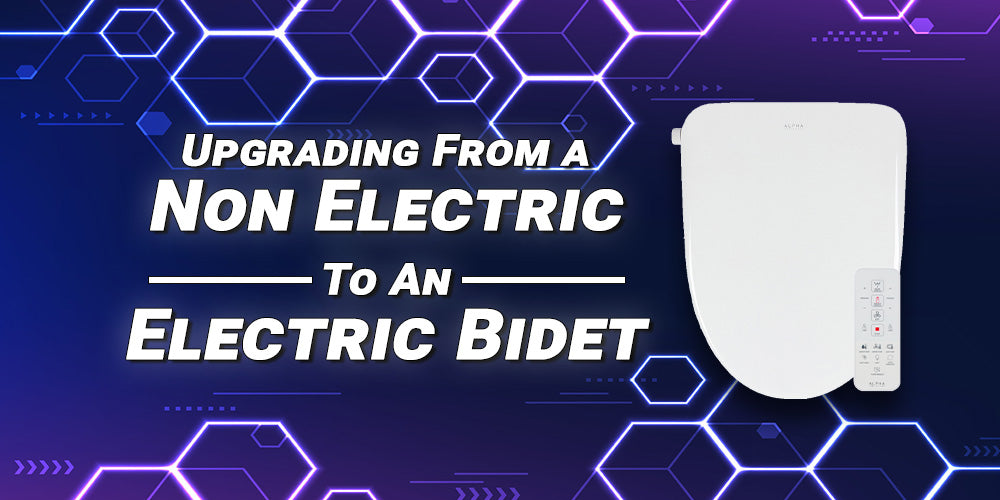A non-electric bidet attachment is a great introductory option for those just starting out and dipping their toes into the world of bidets. Simple and easy to use, a non-electric bidet skips out on all the bells and whistles included in electric bidets in favor of a more straightforward cleansing experience.
But after growing comfortable and familiar with their non-electric bidet, many users desire a more refined experience. Features such as warm water, heated seat, a warm air dryer, and a deodorizer come to mind.
One cannot understate the comfort and luxury a bidet with said features brings to the bathroom experience. Many users find that once they use a bidet with warm water and a heated seat, going back to a non-electric bidet has them wishing for more.
In this article, we will discuss what one should look for when making the switch from a non-electric bidet to an electric model. While there are many advantages to electronic bidet seats, there are also some important drawbacks to consider. You may find that you prefer a simple non-electric attachment. So without further ado, let’s jump right in.
Reasons for Upgrading to an Electric Bidet Seat
The main reason for considering a switch from a non-electric bidet to an electric model is quite obvious - more features. Non-electric bidets can provide a great cleaning experience and are generally very affordable and easy to install. However, their clunky appearance when installed and lack of warm water are the main drawbacks. A non-electric bidet does not offer any warming features such as a warm water spray, heated seat, or warm air dryer.
Especially true for those who live in colder climates, having a bidet that can provide on demand warm water, a heated seat, and warm air dryer is a godsend when using the bathroom during the cold winter months. In the frigid mornings you’ll sit on a warm seat, get cleansed with warm water, and then you can either dab dry with toilet paper or use the warm air dryer. A comfortable and pleasant experience all around.
Not only do electric bidet seats provide a heated seat and warm water spray, but also other useful features such as a soft close seat and lid, deodorizer, one button wash and dry function, user presets, LED night light, and much more. Although these features aren’t required to achieve an efficient and complete clean, they are sure nice to have.
If you have any concerns regarding power consumption with an electric bidet, don’t! Power consumption is minimal and many electric bidets have an energy saving mode which can help conserve even more energy.
Users who have limited mobility can also benefit more from electric bidet seats than non-electric bidets. Because they are controlled by buttons on a remote control, they are much easier to control and operate as fine motor skills aren’t required. By using the dryer, the entire toileting experience can be completely hands-free.
Drawbacks to Consider
What are some potential drawbacks when making the switch? First, and most importantly, electric bidet seats have a completely different type of spray than non-electric attachments. This is due to the fact that non-electric bidets are essentially just valves that open and close. They can use the full force of your home's water pressure to power its spray - resulting in very high pressure and volume.
Electric bidet seats need to heat the water as they are spraying you, and thus use built-in pumps that regulate the spray pressure. The spray is also aerated for added comfort and cleansing ability. The spray will feel noticeably weaker compared to a non-electric bidet, but is every bit as effective for cleansing. Those who have grown accustomed to and comfortable with the strong spray pressures associated with non-electric models will have to get used to a different kind of spray with electric models.
Another drawback is the need for a GFCI outlet within reach of your electric bidet. Most electric bidets have a 4ft long electrical cord. If your bathroom does not have a GFCI outlet within 4 feet of your bidet, then using an extension cord is an easy solution to power the bidet. Alternatively, one can opt to have an outlet installed near their toilet if they so desire.
The last main drawback of electric bidet seats is the higher price tag. Good quality bidet seats can range from $250 - $1300, whereas non-electric attachments can be had for as little as $25.
Conclusion
If you have any doubts as to whether to upgrade your non-electric bidet to an electric model, stop doubting! The improvement in build quality, comfort, and features far outweighs the drawbacks. Installing an electric bidet to your bathroom can be that finishing touch that brings your bathroom into the 21st century. Not only will you enjoy a more comfortable cleaning experience but you will also be doing it with style!









